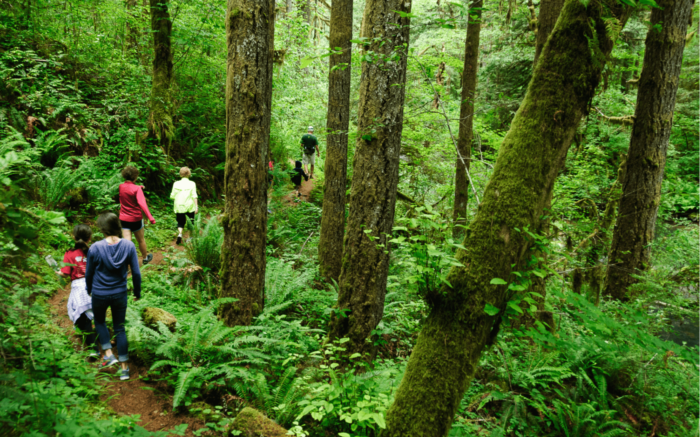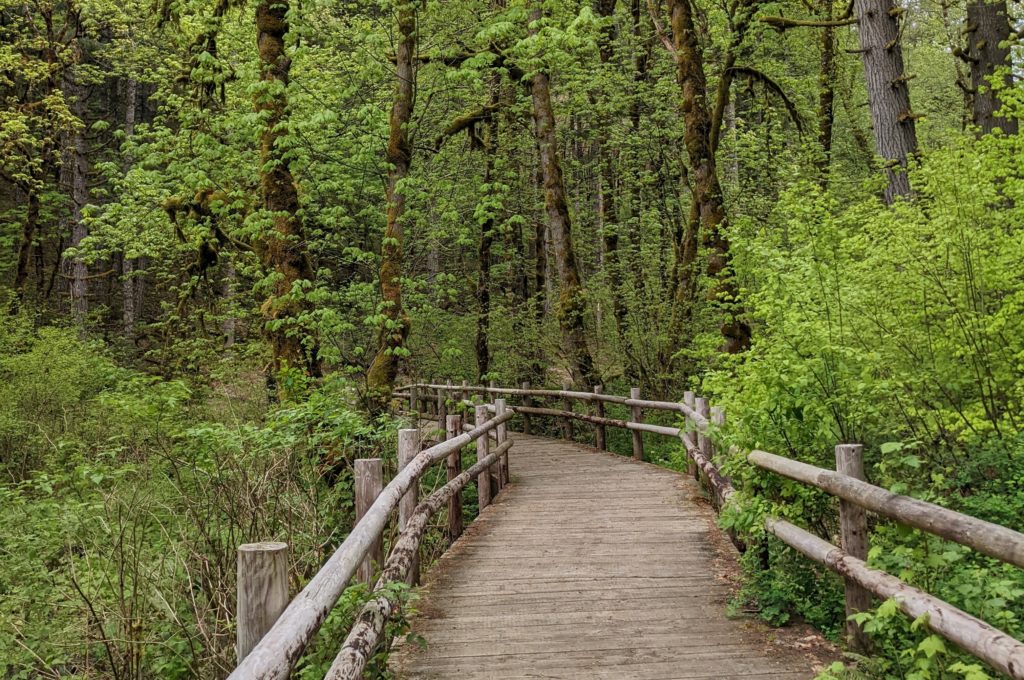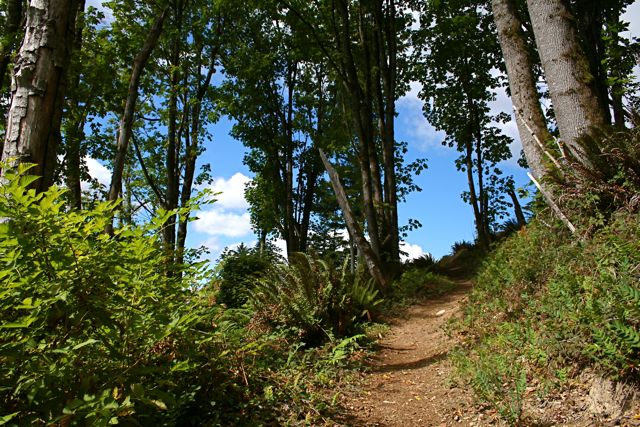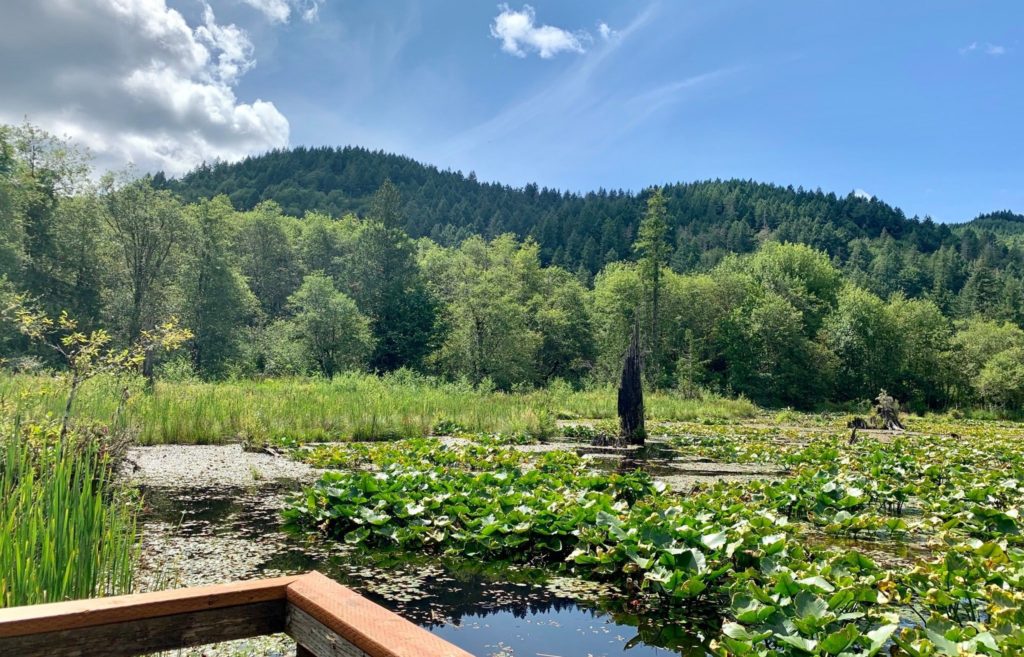Get Outside! Enjoying FSC®-Certified Forests

Many Forest Stewardship Council®-certified forests in the Pacific Northwest are open for public enjoyment.
These lands offer an opportunity for all of us to know what healthy forests look and feel like.
Some of these forests have recently had restoration treatments that entailed removing little trees to make room for the remaining trees to grow bigger; encouraging the woods to develop more-complex structure and species diversity. In other forests, the trees that fire would have naturally thinned-out have been removed through harvest to help Oregon white oaks and ponderosa pines grow big and reclaim their historic range and places they are well-adapted to grow in the future.
Still, in other FSC-certified forests the goal is to support the perpetual harvest of timber to meet our wood products needs locally and globally – while also protecting clean air and drinking water, sustaining stream and wildlife habitat. These forests help sustain rural economies, schools, and supply wood for homes, businesses, design and craft.
The next time you’re looking to explore a forest or take a walk in the woods, consider going to one of these FSC-certified forests that are open to the public:
- Beazell Memorial Forest – King’s Valley, OR
- Black Diamond Open Space – Black Diamond, WA
- Bratton Canyon – Woodland, WA
- Central Cascades Forest – Cle Elum, WA
- Capitol State Forest – Olympia, WA
- Carkeek Park – Seattle, WA
- Cemetery Reach Natural Area – Ravensdale, WA
- Chehalem Ridge Nature Park – Forest Grove, OR
- Clearwater Forest Reserve – Clearwater, WA
- Cowling Creek Forest Preserve – Suquamish, WA
- Discovery Park – Seattle, WA
- Elbe Hills State Forest – Eatonville, WA
- Ellsworth Creek Preserve – Willapa Bay, WA
- Green Mountain State Forest – Crosby, WA
- Grover’s Creek Preserve – Indianola
- Henry’s Ridge Open Space – Black Diamond, WA
- Hoh River Recreation and Conservation Area – Jefferson County, WA
- Island Center Forest – Vashon Island, WA
- Jefferson Land Trust’s Bulis Preserve – Port Townsend, WA
- Lake Rosannah – La Center, WA
- Nisqually Land Trust‘s Mashel River Protected Area – Yelm, WA
- Northwest Trek – Eatonville, WA
- Ravensdale Retreat Natural Area – Black Diamond, WA
- Schmitz Park – Seattle, WA
- Seward Park – Seattle, WA
- Tahoma State Forest – Ashford, WA
- Tahuya State Forest – Belfair, WA
- Tarboo Wildlife Preserve – Quilcene, WA
- Taylor Mountain Forest – Hobart, WA
- Tiger Mountain State Forest – Issaquah, WA
- Turtleback Mountain – Orcas Island, WA

Beazell Memorial Forest, Benton County, OR

Taylor Mountain Forest, King County, WA

Capitol State Forest, Thurston County, WA

One Comment
I managed a FSC-NNRG forests for the Girl Scouts of Western Washington for many years prior to retirement in 2018. I am still involved in several volunteer/citizen science endeavors, two of which (locating indigenous bear grass prairies and golden chinquapins) take me to WADNR managed lands quite often in the Hood Canal area. I have observed over the past several years WADNR’s practice of broadcast herbicide spraying of recent clearcuts eliminating all vegetation prior to planting. This practice precludes, forever, the possibility of locating the two plants species I am working with in those locations, to say nothing of the myriad other organisms that are eliminated from the diversity of the treated area and over time the entire landscape. I do remember that as part of FSC certification we were required to carefully record all of the details of any herbicide use down to the ounce and thought FSC had some stricter standards for herbicide use?
I am wondering how the WADNR scorched earth policy reconciles with their advertising that they are FSC certified. In my opinion it is unsustainable and greatly dilutes value of FSC to others who are certified!
Would like to hear of FSC/NNRG standards and some comments on this issue?
Thank you